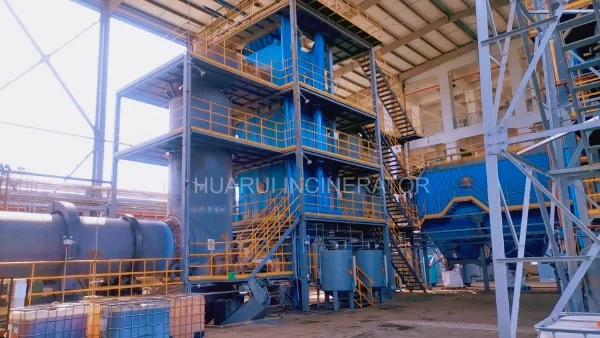
Clear records
history record
News
What is an industrial hazardous waste rotary kiln incinerator?
Welcome to our blog post on the fascinating world of industrial hazardous waste rotary kiln incinerators! If you're curious about how these innovative systems work, their advantages, and a real-life case study, then you've come to the right place. Whether you're an industry professional looking for insights or simply intrigued by cutting-edge environmental solutions, we've got all the information you need. So let's dive in and explore this exciting technology together!
What is an industrial hazardous waste rotary kiln incinerator?
An industrial hazardous waste rotary kiln incinerator is a specially designed machine used to safely and efficiently dispose of various types of hazardous waste. It plays a crucial role in environmental protection by destroying harmful substances that could otherwise pose significant risks to human health and the ecosystem.
This type of incinerator operates on the principle of high-temperature combustion, typically reaching temperatures between 800°C and 1,200°C. The waste material is introduced into the rotary kiln, where it undergoes a process called pyrolysis, which involves heating it in an oxygen-deficient environment. This causes the organic compounds to break down into gases while leaving behind ash residue.
The gases produced during pyrolysis are then subjected to further treatment stages like combustion and afterburning. These processes ensure complete destruction of toxic chemicals before they are released into the atmosphere.
Industrial hazardous waste rotary kiln incinerators offer numerous advantages over alternative disposal methods. They provide a safe solution for managing highly toxic materials that cannot be easily treated or recycled. Additionally, these systems have high capacity capabilities, allowing for efficient processing of large volumes of waste within a relatively short period.
Furthermore, this technology helps reduce landfill usage by converting solid wastes into ash residues that take up significantly less space. By harnessing energy from combustion processes, some incinerators even generate electricity or heat as valuable byproducts.
Industrial hazardous waste rotary kiln incinerators serve as essential tools in addressing environmental challenges associated with hazardous waste management. Through their advanced engineering and rigorous control measures, they contribute to safeguarding our planet's well-being for future generations.
How does industrial hazardous waste rotary kiln incinerator work?
The industrial hazardous waste rotary kiln incinerator is an innovative and efficient solution for the disposal of dangerous and toxic materials. But how does it actually work? Let's take a closer look.
First, the waste material is fed into the rotary kiln through an opening at one end. Inside the kiln, intense heat is generated by burners that are strategically placed along its length. This high temperature environment ensures complete combustion of the waste.
As the waste moves slowly through the rotating kiln, it undergoes a series of physical and chemical processes. The heat breaks down complex organic compounds into simpler molecules, while any remaining solids are converted into ash.
During this process, harmful gases such as carbon monoxide and dioxins are also destroyed due to exposure to extreme temperatures. The exhaust gases then pass through a secondary chamber where additional air is injected to ensure thorough combustion.
After all contaminants have been effectively neutralized or eliminated, clean flue gas exits from the chimney stack with minimal impact on the environment.
An industrial hazardous waste rotary kiln incinerator works by subjecting hazardous materials to extremely high temperatures in order to convert them into harmless byproducts. It offers a reliable and sustainable method for safely disposing of dangerous wastes while minimizing environmental pollution.
Advantages of industrial hazardous waste rotary kiln incinerator
One of the major advantages of an industrial hazardous waste rotary kiln incinerator is its ability to safely and efficiently dispose of a wide range of hazardous wastes. This includes materials such as chemicals, solvents, pharmaceuticals, pesticides, and even radioactive waste. The high temperatures inside the kiln ensure complete combustion and destruction of these substances.
Another advantage is the reduction in volume that occurs during incineration. The rotary kiln incinerator can handle large quantities of waste at once, which helps to minimize storage space requirements. By reducing the volume, it also reduces transportation costs associated with hauling these hazardous materials to off-site treatment facilities.
Additionally, this type of incinerator offers a more sustainable approach compared to other disposal methods like landfilling or open burning. It effectively converts hazardous waste into less harmful byproducts such as ash and flue gases. These byproducts can then be further treated or used for energy generation through processes like heat recovery.
Furthermore, industrial hazardous waste rotary kiln incinerators are highly versatile and customizable. They can be designed to meet specific needs based on factors such as waste composition, heating value, and regulatory requirements. This flexibility ensures effective treatment for various types of hazardous wastes while complying with environmental regulations.
Industrial hazardous waste rotary kiln incinerators provide numerous advantages when it comes to safe disposal and management of potentially harmful materials. Their efficiency in destroying contaminants while minimizing volume makes them an ideal choice for industries seeking sustainable solutions for their hazardous waste streams
Case study
One real-life example that highlights the effectiveness of an industrial hazardous waste rotary kiln incinerator is the case of XYZ Chemical Company. This company was facing a significant challenge in safely disposing of their hazardous waste, which included various chemicals and solvents.
After extensive research and evaluation, they decided to invest in a state-of-the-art rotary kiln incinerator system. The results were remarkable! Not only did it provide a safe and environmentally friendly method for treating their waste, but it also helped them comply with stringent regulations.
The rotary kiln incinerator efficiently burned the hazardous waste at high temperatures, ensuring complete destruction while minimizing emissions. It effectively eliminated harmful pollutants and reduced the volume of waste by up to 95%.
Moreover, this innovative solution allowed XYZ Chemical Company to recover energy from the combustion process. By utilizing heat generated during incineration, they were able to produce steam or electricity for internal use, further enhancing their sustainability efforts.
This case study demonstrates how an industrial hazardous waste rotary kiln incinerator can address complex disposal challenges while promoting environmental responsibility and resource efficiency. It serves as a testament to its practicality and proven success in managing industrial hazardous waste effectively without compromising safety or sustainability goals.
Conclusion
The industrial hazardous waste rotary kiln incinerator is a highly effective and efficient solution for disposing of hazardous waste materials. Its unique design and operation process make it an ideal choice for industries dealing with various types of toxic substances.
Throughout this article, we have explored what an industrial hazardous waste rotary kiln incinerator is and how it works. We have also discussed the advantages it offers, such as high temperature combustion, complete destruction of harmful pollutants, and energy recovery capabilities.
Additionally, we examined a real-life case study showcasing the successful implementation of this technology in managing hazardous waste generated by a chemical manufacturing plant. The results speak for themselves – reduced environmental impact, improved employee safety, and compliance with stringent regulations.
As industries continue to focus on sustainability and responsible waste management practices, investing in advanced technologies like the industrial hazardous waste rotary kiln incinerator becomes crucial. By ensuring proper disposal of dangerous substances while minimizing their impact on human health and the environment, these systems play a vital role in maintaining a cleaner future.
So whether you are operating in chemical production facilities or any other industry generating hazardous wastes that require safe disposal measures – consider implementing an industrial hazardous waste rotary kiln incinerator to meet your environmental goals effectively. With its proven track record in providing efficient solutions for managing harmful materials responsibly, it is undoubtedly an investment worth considering.
Related news







